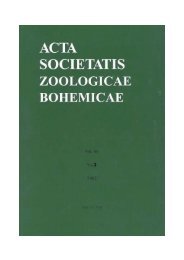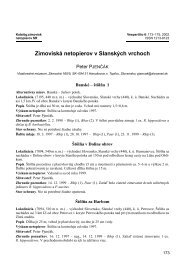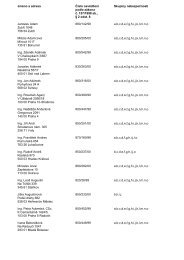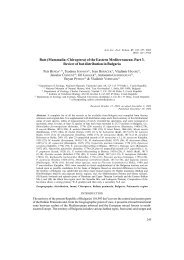Untitled
Untitled
Untitled
You also want an ePaper? Increase the reach of your titles
YUMPU automatically turns print PDFs into web optimized ePapers that Google loves.
Asteroids: Their composition and impact threat<br />
the parent body of the HEDs (e.g. Consolmagno and<br />
Drake, 1977).<br />
E asteroids, due to their relatively featureless spectra and<br />
high albedos (greater than 0.3), have been interpreted as<br />
having surfaces composed predominately of an essentially<br />
iron-free silicate (e.g. Zellner et al. 1977). The most obvious<br />
meteoritic analog is the aubrites (enstatite achondrites),<br />
which are igneous meteorites composed primarily of essentially<br />
iron-free enstatite (Watters and Prinz 1979). However,<br />
the identification of an absorption feature in the 3 µm wavelength<br />
region of a number of main-belt E-asteroid spectra<br />
(Rivkin et al., 1995) has been interpreted as indicating hydrated<br />
minerals on the surfaces of some of these objects,<br />
which is inconsistent with an igneous origin. A feature centered<br />
at ~ 0.5 µm has also been identified in a number of E-<br />
class asteroids (Bus 1999, Fornasier and Lazzarin 2001) and<br />
these objects have been classified as Xe by Bus and Binzel<br />
(2002b) (Figure 2). This feature is believed to be due to a<br />
sulfide (Burbine et al. 2002a), which is commonly found in<br />
aubrites (Watters and Prinz 1979).<br />
The surface mineralogies of many other asteroid classes<br />
are thought to be somewhat understood. The K-class asteroids<br />
tend to have visible and near-infrared spectral<br />
properties similar to CO3/CV3 chondrites (Bell 1988,<br />
Burbine et al. 2001a, Burbine and Binzel 2002). Q asteroids<br />
(most notably 1862 Apollo) tend to have spectral<br />
properties similar to ordinary chondrites. D and P objects,<br />
which tend to be found in the outer main belt, are thought<br />
to have very primitive, organic-rich surfaces due to their<br />
relatively featureless and red spectra (e.g. Vilas and Gaffey,<br />
1989). R asteroids (most notably 349 Dembowska)<br />
appear to be mixtures of olivine and pyroxene (Gaffey et<br />
al., 1989). T asteroids tend to be very dark and featureless<br />
and Hiroi and Hasegawa (2002) have noted the spectral<br />
similarity of unusual carbonaceous chondrite Tagish Lake<br />
to T asteroids.<br />
The surface compositions of a few asteroid classes are<br />
unclear, but do appear to contain silicates. O-asteroid 3628<br />
Božněmcová has a 1 µm feature unlike any known meteorite<br />
(Burbine and Binzel 2002). L class objects have been<br />
newly defined by Bus and Binzel (2002b) and appear intermediate<br />
in spectral properties in the visible between the<br />
K and some S asteroids.<br />
Spacecraft missions<br />
The first dedicated asteroidal mission was the NEAR-<br />
Shoemaker spacecraft rendezvous with S-asteroid 433<br />
Eros (e.g. McCoy et al. 2002) and its flyby of C-asteroid<br />
253 Mathilde (e.g. Veverka et al. 1999). NEAR-Shoemaker<br />
Spacecraft obtained high-resolution images, reflectance<br />
spectra of different lithologic units, bulk density, magnetic<br />
field measurements, and bulk elemental compositions of<br />
433 Eros. Eros had a density of ~ 2.7 g/cm 3 , consistent<br />
with a silicate-rich assemblage while Mathilde had an extremely<br />
low density of 1.3 g/cm 3 .<br />
Eros was classified as an S(IV) object (Murchie and<br />
Normalized Reflectance<br />
3.5<br />
3<br />
2.5<br />
2<br />
1.5<br />
1<br />
Bouvante (eucrite)<br />
1929 Kollaa (V)<br />
Ehole (H5)<br />
6 Hebe (S)<br />
289 Neneta (A)<br />
0.5<br />
0.4 0.8 1.2 1.6 2 2.4<br />
Wavelength (µm)<br />
Fig. 3. Reflectance spectra of S-asteroid 6 Hebe versus H5 chondrite<br />
Ehole, A-asteroid 289 Nenetta, and 1929 Kollaa versus eucrite Bouvante.<br />
The 6 Hebe and 289 Nenetaa spectra are a combination of data from<br />
Binzel and Bus (2002a) and Bell et al. (1988) while the 1929 Kollaa<br />
spectrum is a combination of data from Binzel and Bus (2002a) and Burbine<br />
and Binzel (2002). All spectra are normalized to unity at 0.55 µm<br />
and offset in reflectance from each other. Error bars are one sigma. All<br />
the Binzel and Bus (2002a) and the Burbine and Binzel (2002) spectra<br />
are available at the website http://smass.mit.edu. The Bouvante spectrum<br />
is from Burbine et al. (2001b) and was taken at Brown University’s<br />
RELAB facility.<br />
Pieters 1996) and it was hoped that the NEAR-Shoemaker<br />
data would help “solve” the S-asteroid/ordinary chondrite<br />
question. The average olivine to pyroxene<br />
composition derived from band area ratios (McFadden et<br />
al. 2001) and elemental ratios (Mg/Si, Fe/Si, Al/Si, and<br />
Ca/Si) derived from X-ray data (Nittler et al. 2001) of Eros<br />
are consistent (McCoy et al. 2001) with ordinary chondrite<br />
compositions. However, the S/Si ratio derived from X-ray<br />
data (Nittler et al. 2001) and the Fe/O and Fe/Si ratios derived<br />
from gamma-ray data (Evans et al. 2001) are significantly<br />
depleted relative to ordinary chondrites. McCoy et<br />
al. (2001) believe that the best meteoritic analogs to Eros<br />
are an ordinary chondrite, whose surface mineralogy has<br />
been altered by the depletion of metallic iron and sulfides,<br />
or a primitive achondrite, derived from a precursor assemblage<br />
of the same mineralogy as one of the ordinary chondrite<br />
groups.<br />
What is the percentage of near-Earth asteroids<br />
with iron meteorite compositions?<br />
What is extremely difficult from Earth to determine is<br />
if an object has a composition similar to iron meteorites.<br />
This is a problem since for a particular size, the biggest<br />
249








